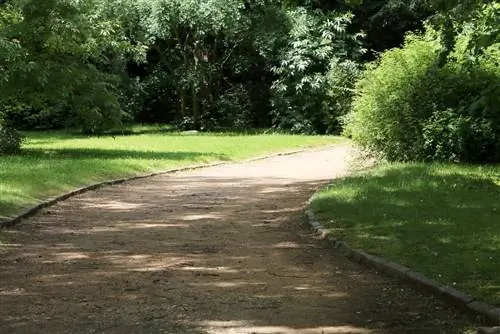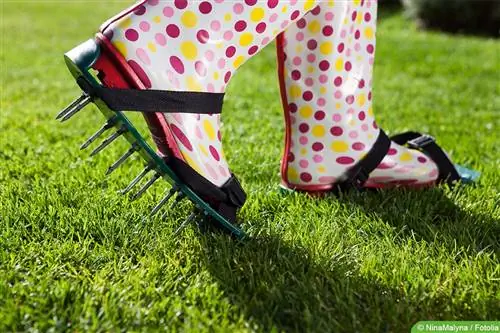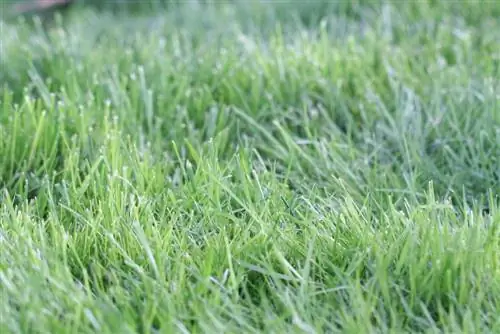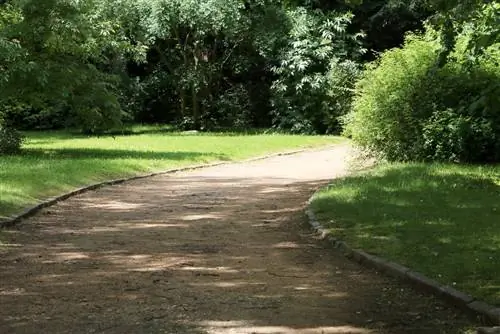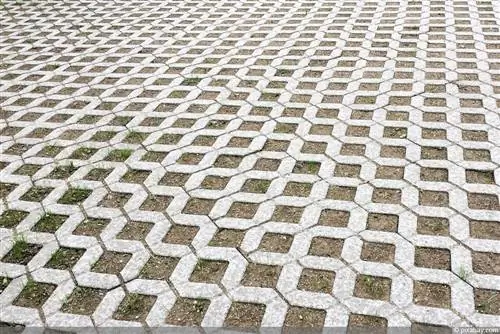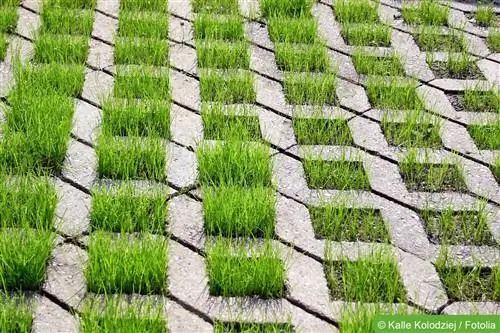- Author admin [email protected].
- Public 2023-12-17 03:39.
- Last modified 2025-06-01 06:48.
The lawn usually takes up by far the largest space in the garden. But that also means that it borders practically everywhere - on beds, trees and bushes as well as on sidewalks, sheds and house walls. It makes perfect sense to separate the individual areas from the lawn using so-called mowing edges. This is even strongly recommended for beds.
Basic problem
Grasses naturally tend to spread uncontrollably. If you give them free rein, they will constantly conquer new territory. Basically, that's not wrong. However, in the garden it can create a lot of mess and cause problems with growth. You definitely don't want unwanted grass, especially in beds and shrubs. To avoid this, strict demarcation from the lawn is necessary. The so-called lawn edging stones have proven to be ideal. They reliably ensure that limits are placed on the growth of the lawn. The prerequisite for this: They have to be between ten and 15 centimeters deep in the ground. Consequently, a small trench must be dug for the stones and possibly also a foundation to accommodate the stone barrier.
Lawn edge stones
Lawn edging stones are available from garden retailers or hardware stores. They are available as cast concrete in different shapes and designs or as natural stones. Which one you choose is primarily a question of personal taste - and your wallet. Natural stones are sometimes significantly more expensive than cast stones. Depending on the design and size, costs of 2.50 to 6 euros per running meter must be expected for cast concrete blocks. How many stones you actually need depends of course on the length of the boundary that is to be set. Precise measurements are therefore mandatory in advance in order to be able to determine requirements. It is advisable to measure generously. This is especially true if the stones are not to be arranged in a straight line, but rather curved or in a circle.
Tip:
For larger quantities, you should definitely have the lawn edging stones delivered by truck, as they can quickly add up to a considerable weight that your own car is usually no longer designed to handle.
Tools and materials

The most important tool needed to set lawn edge stones is a so-called paving hammer, which is used to knock the stones into place. You should not even attempt to hammer it with a conventional hammer, as there is a high risk of the stones breaking. Paving hammers are available in different designs. The simplest of these is certainly the rubber mallet. The hammer head is not made of metal, but rather of robust hard rubber. It is completely sufficient for installing lawn mowing edges. A good rubber hammer can be purchased at hardware stores for around ten euros. You also need the following tools:
- Spade
- meter stick
- Spirit level
- string
- Stomper
When it comes to the other materials, the effort is also extremely clear. We generally recommend conventional building sand on which the stones are placed if they are laid without a foundation. If, on the other hand, a foundation is required, cement and water are required in addition to sand. If the stones are not to be laid in a straight line, but rather in a winding or circle, it is advisable to draw the shape on cardboard in advance and cut it out. Conventional boxes are ideal for this.
Dig a ditch
First you have to dig a small trench in which the stones will later find space. The trench is logically drawn at the border between the lawn and, for example, the beds. He follows this limit. To do this, you dig up soil with a spade. The spade blade determines the width. The depth, however, depends on the height of the lawn edging stones purchased. As a rule of thumb, the stones should protrude two to three centimeters above the surface of the earth. This maximum of three centimeters must first be subtracted. However, you should add 1.5 to two centimeters for a sand filling and up to three centimeters for a foundation.
Foundation
When the trench is dug, it is usually decided whether a foundation is needed. If the soil turns out to have a lot of clay, you can safely do without it and make do with a sand base. However, if it is very sandy, there must be a foundation to permanently prevent the stones from sinking. Even if it takes more work, a foundation is generally recommended. On the one hand, it secures the small stone wall that you pull down. On the other hand, it forms an almost insurmountable barrier for the grass roots.
Insert foundation
If the soil contains clay, it is sufficient, as I said, to simply add a layer of sand to the trench on which the stones will later lie. This layer should be as uniform as possible and have a maximum height of two centimeters. Construction or masonry sand is ideal for this. If you decide to build a foundation instead, mortar must first be made. To do this, mix four parts of coarse masonry sand with one part of cement and relatively little water in a large bucket or tub. The goal is a substance that is as tough as possible. This mortar is then poured evenly into the trench and tamped down with a tamper. As soon as it has dried a little, the stones can then be laid on top.
Note:
With the 4:1 mixture, the dried mortar can be removed relatively easily later if necessary. So you don't build here for eternity.
Laying stones
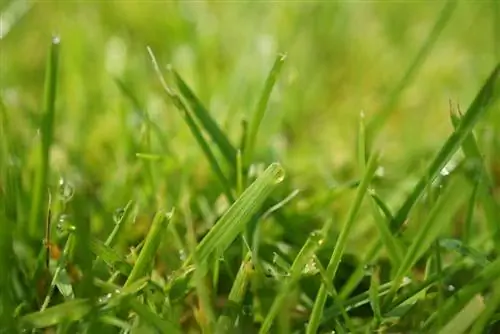
Laying the lawn edging stones is then child's play. It is important that they are as close to each other as possible. You can use a paving hammer to help here. The stones are not only tapped into place with the hammer from above, but also from the side that is still free. It goes without saying that the stones should be flat on the top. Differences in height can be equalized with a hammer. To be on the safe side, a spirit level should definitely be used. In order to achieve a really straight line, it is best to stretch a cord along the entire length of one of the sides, which you can use as a guide. Once all the stones have been laid, the edges of the trench are filled with soil and then tapped or trampled down.
curves
It may be that for aesthetic reasons or simply because the topography dictates it, you don't have to create a straight stone course, but rather a curved one. First, proceed as described above. But in order to get really clean curves, we recommend using a template that you apply repeatedly when setting the stones. You should also pay special attention to the spaces between the individual stones. As already mentioned, the stones should be as close together as possible. This is usually very difficult to do with round shapes. Gaps usually form. These should definitely be closed with mortar to ensure that the lawn barrier is really tight.
Suitability for everyday use
Once laid, lawn edging stones no longer require much attention or care. They are hardly noticeable in everyday life, although the clear demarcation makes mowing the lawn much easier, for example. The height of two to three centimeters that they protrude from the ground is not a problem for all standard lawnmowers. The stones are of course also winter hardy and can withstand frost. In the fall you should just clean them of coarse dirt with water. Otherwise you are guaranteed to have no more work.

